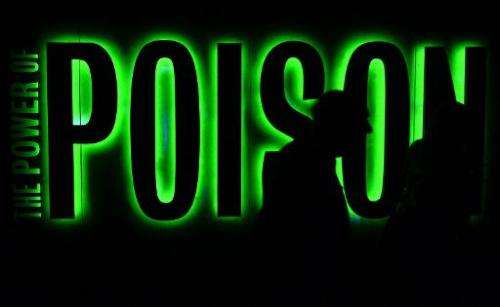People arrive to visit "The Power of Poison" exhibition during a preview at the American Museum of Natural History in New York, November 12, 2013.
The powers of poison will be on full display in New York's Museum of Natural History starting Saturday, when a new exhibit opens.
The display "reveals the strange and even intriguing things that happen when humans and toxic substances collide," said museum director Ellen Futter.
"What evolved in animals and plants as a defense against predators or a means of preying has been used by humans throughout history for magic, murder, villainy, intoxication, and, increasingly, groundbreaking medicine," she added.
Poison has already been making headlines this month: last week, forensic analysis suggested Yasser Arafat, the ex-leader of the Palestinians, may have been poisoned when he died in 2004, lending credence to longstanding accusations.
At the museum in New York, visitors can start by exploring a section dedicated to the Choco forest, which is in northwest Colombia, known as the home to numerous venomous species.
The exhibit also displays three golden poison frogs, the Phyllobates terribilis, which has skin infused with enough poison to kill ten people.
Of course poisonous creatures are not rare: Ants, caterpillars, scorpions, spiders and fish all have various species with venom.
But, at least according to popular belief, the most dangerous are snakes. And indeed, of 3,000 species worldwide, between 250 and 500 possess toxic substances capable of sparking serious health problems among humans.
But what makes venom special is not so much its presence in the animal kingdom as its use—since ancient times—as a source of power or magic.
Along those lines, the exhibit explores myths, fairy tales, and legends surrounding poison: from Snow White's bite of a poisoned apple, to the witches in Shakespeare's "Macbeth," to the Mad Hatter of Lewis Carroll's "Alice in Wonderland."
Also given space in "The Power of Venom" are the mystery novels of Arthur Conan Doyle and Agatha Christie, as well as historical figures, including Roman emperor Nero, who used a professional "poisoner" to get rid of his enemies, and Egyptian queen Cleopatra who, according to legend, committed suicide by cobra bite.
© 2013 AFP






















